CVAD Bloodstream Infections: Prevention and Management Strategies
VerifiedAdded on 2023/04/21
|9
|2315
|270
Essay
AI Summary
This essay discusses catheter-associated bloodstream infections (BSI) arising from central venous access devices (CVADs), focusing on prevention and management strategies within intensive care settings. It highlights that CVADs, while beneficial for fluid and medication administration, pose risks such as occlusion, thrombosis, and bloodstream infections. The essay uses a case study to illustrate how improper catheter insertion and maintenance can lead to complications like sepsis. Key preventive measures discussed include sterile insertion techniques, regular site cleaning with antiseptics, routine dressing changes, and visual monitoring for infection signs. Nursing care and management are emphasized for early assessment, monitoring, and documentation of complications. The conclusion underscores the importance of adherence to sterile practices and proper catheter management to minimize the risk of CVAD-associated BSIs and improve patient outcomes.
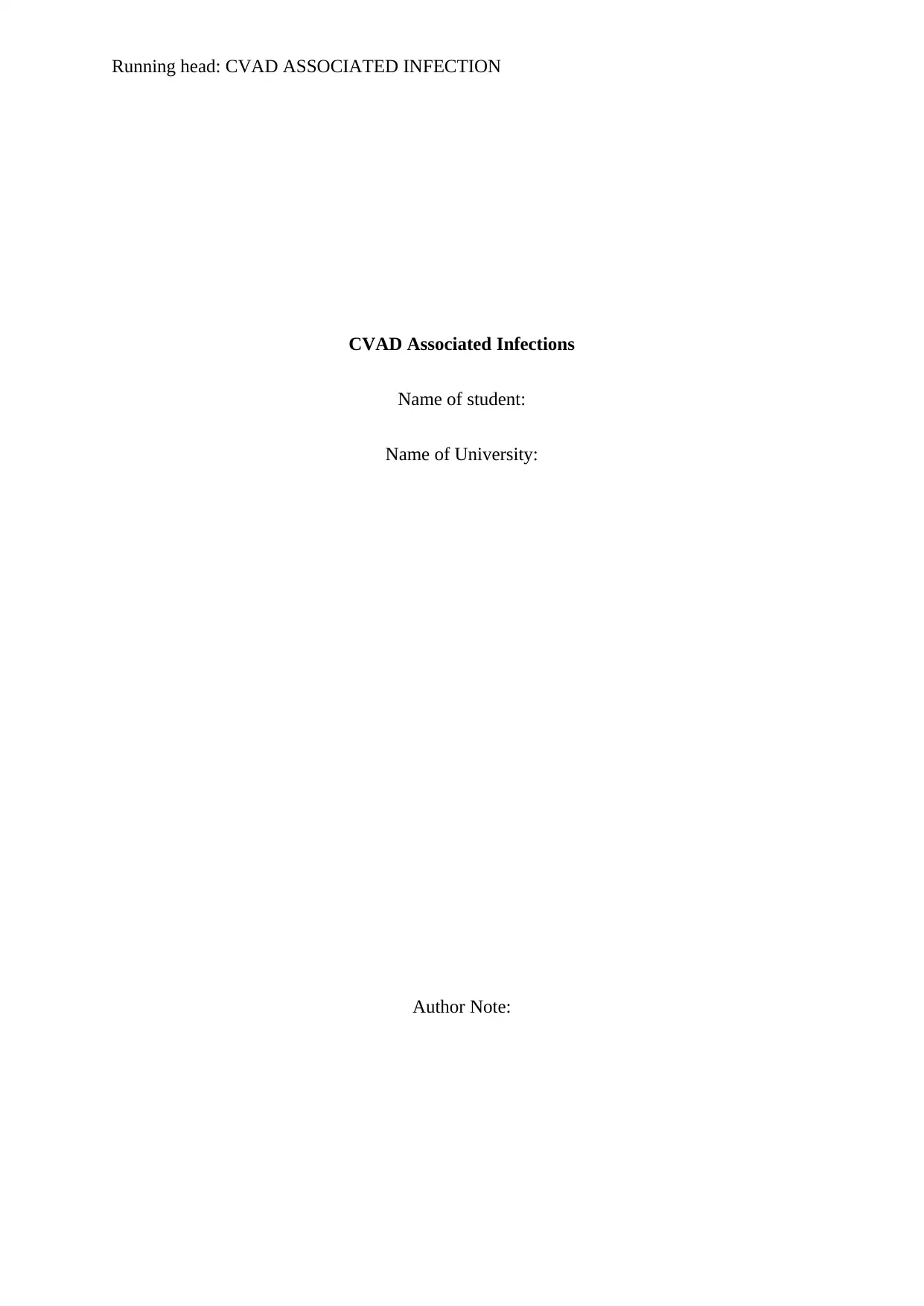
Running head: CVAD ASSOCIATED INFECTION
CVAD Associated Infections
Name of student:
Name of University:
Author Note:
CVAD Associated Infections
Name of student:
Name of University:
Author Note:
Paraphrase This Document
Need a fresh take? Get an instant paraphrase of this document with our AI Paraphraser

1CVAD ASSOCIATED INFECTION
Introduction
Catheter associated infections are now an increasing cases observed in hospital
settings, particularly in intensive care units for people who are admitted in critically serious
conditions.
This blood infections are one of the most frequent and lethal complications that arise among
patients who are subjected to intravenous catheters. CVAD or Central Venous Access
Devices are the venous catheter devices that are provided to a patient through injection
through a vein so as to allow the supply of fluids, blood products, medications like
antibiotics; other medication therapies are also provided through catheter devices into the
bloodstream of the patients. The insertion of catheter devices through veins are intended to
improve the critical conditions of the patients; however complications arise with the insertion
of venous catheter devices (Cotogni and Pittiruti 2014). Although catheters are safe to be
inserted, serious complications like occlusion phenomenon of catheter, venous thrombosis
and even blood stream infection can result and lead to debilitating conditions of the patients.
Discussion
The hospital acquired infections of patients admitted in intensive care unit or ICU are
potential causes of morbidity and mortality of critical patients in ICU. The deleterious
consequences of infect ions depend on the causal microbial agents which give rise to blood
stream infections due to catheter insertions (Ullman et al. 2015). The intravenous insertion of
catheters provide supplemental nutrition to the patients; this purpose is served through venous
insertion of catheter devices. However, the potential risk factors associated with catheter
insertion and the site of its insertion, the occlusion of catheter due to poor dressing,
accumulation of moisture content at the site of insertion (moisture attracts microbial
contaminants which insert through the veins into the blood stream), contamination of the
Introduction
Catheter associated infections are now an increasing cases observed in hospital
settings, particularly in intensive care units for people who are admitted in critically serious
conditions.
This blood infections are one of the most frequent and lethal complications that arise among
patients who are subjected to intravenous catheters. CVAD or Central Venous Access
Devices are the venous catheter devices that are provided to a patient through injection
through a vein so as to allow the supply of fluids, blood products, medications like
antibiotics; other medication therapies are also provided through catheter devices into the
bloodstream of the patients. The insertion of catheter devices through veins are intended to
improve the critical conditions of the patients; however complications arise with the insertion
of venous catheter devices (Cotogni and Pittiruti 2014). Although catheters are safe to be
inserted, serious complications like occlusion phenomenon of catheter, venous thrombosis
and even blood stream infection can result and lead to debilitating conditions of the patients.
Discussion
The hospital acquired infections of patients admitted in intensive care unit or ICU are
potential causes of morbidity and mortality of critical patients in ICU. The deleterious
consequences of infect ions depend on the causal microbial agents which give rise to blood
stream infections due to catheter insertions (Ullman et al. 2015). The intravenous insertion of
catheters provide supplemental nutrition to the patients; this purpose is served through venous
insertion of catheter devices. However, the potential risk factors associated with catheter
insertion and the site of its insertion, the occlusion of catheter due to poor dressing,
accumulation of moisture content at the site of insertion (moisture attracts microbial
contaminants which insert through the veins into the blood stream), contamination of the
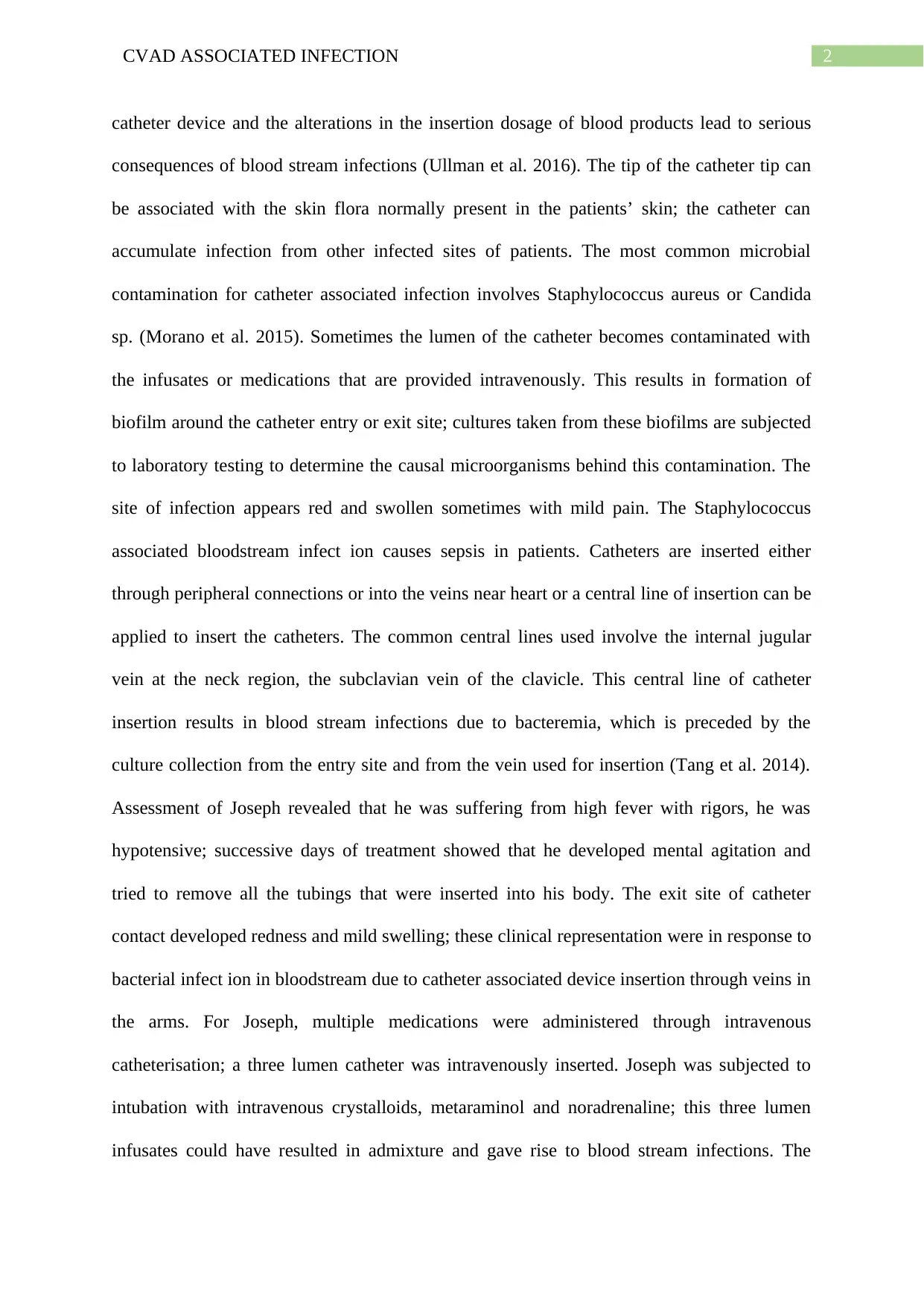
2CVAD ASSOCIATED INFECTION
catheter device and the alterations in the insertion dosage of blood products lead to serious
consequences of blood stream infections (Ullman et al. 2016). The tip of the catheter tip can
be associated with the skin flora normally present in the patients’ skin; the catheter can
accumulate infection from other infected sites of patients. The most common microbial
contamination for catheter associated infection involves Staphylococcus aureus or Candida
sp. (Morano et al. 2015). Sometimes the lumen of the catheter becomes contaminated with
the infusates or medications that are provided intravenously. This results in formation of
biofilm around the catheter entry or exit site; cultures taken from these biofilms are subjected
to laboratory testing to determine the causal microorganisms behind this contamination. The
site of infection appears red and swollen sometimes with mild pain. The Staphylococcus
associated bloodstream infect ion causes sepsis in patients. Catheters are inserted either
through peripheral connections or into the veins near heart or a central line of insertion can be
applied to insert the catheters. The common central lines used involve the internal jugular
vein at the neck region, the subclavian vein of the clavicle. This central line of catheter
insertion results in blood stream infections due to bacteremia, which is preceded by the
culture collection from the entry site and from the vein used for insertion (Tang et al. 2014).
Assessment of Joseph revealed that he was suffering from high fever with rigors, he was
hypotensive; successive days of treatment showed that he developed mental agitation and
tried to remove all the tubings that were inserted into his body. The exit site of catheter
contact developed redness and mild swelling; these clinical representation were in response to
bacterial infect ion in bloodstream due to catheter associated device insertion through veins in
the arms. For Joseph, multiple medications were administered through intravenous
catheterisation; a three lumen catheter was intravenously inserted. Joseph was subjected to
intubation with intravenous crystalloids, metaraminol and noradrenaline; this three lumen
infusates could have resulted in admixture and gave rise to blood stream infections. The
catheter device and the alterations in the insertion dosage of blood products lead to serious
consequences of blood stream infections (Ullman et al. 2016). The tip of the catheter tip can
be associated with the skin flora normally present in the patients’ skin; the catheter can
accumulate infection from other infected sites of patients. The most common microbial
contamination for catheter associated infection involves Staphylococcus aureus or Candida
sp. (Morano et al. 2015). Sometimes the lumen of the catheter becomes contaminated with
the infusates or medications that are provided intravenously. This results in formation of
biofilm around the catheter entry or exit site; cultures taken from these biofilms are subjected
to laboratory testing to determine the causal microorganisms behind this contamination. The
site of infection appears red and swollen sometimes with mild pain. The Staphylococcus
associated bloodstream infect ion causes sepsis in patients. Catheters are inserted either
through peripheral connections or into the veins near heart or a central line of insertion can be
applied to insert the catheters. The common central lines used involve the internal jugular
vein at the neck region, the subclavian vein of the clavicle. This central line of catheter
insertion results in blood stream infections due to bacteremia, which is preceded by the
culture collection from the entry site and from the vein used for insertion (Tang et al. 2014).
Assessment of Joseph revealed that he was suffering from high fever with rigors, he was
hypotensive; successive days of treatment showed that he developed mental agitation and
tried to remove all the tubings that were inserted into his body. The exit site of catheter
contact developed redness and mild swelling; these clinical representation were in response to
bacterial infect ion in bloodstream due to catheter associated device insertion through veins in
the arms. For Joseph, multiple medications were administered through intravenous
catheterisation; a three lumen catheter was intravenously inserted. Joseph was subjected to
intubation with intravenous crystalloids, metaraminol and noradrenaline; this three lumen
infusates could have resulted in admixture and gave rise to blood stream infections. The
⊘ This is a preview!⊘
Do you want full access?
Subscribe today to unlock all pages.

Trusted by 1+ million students worldwide
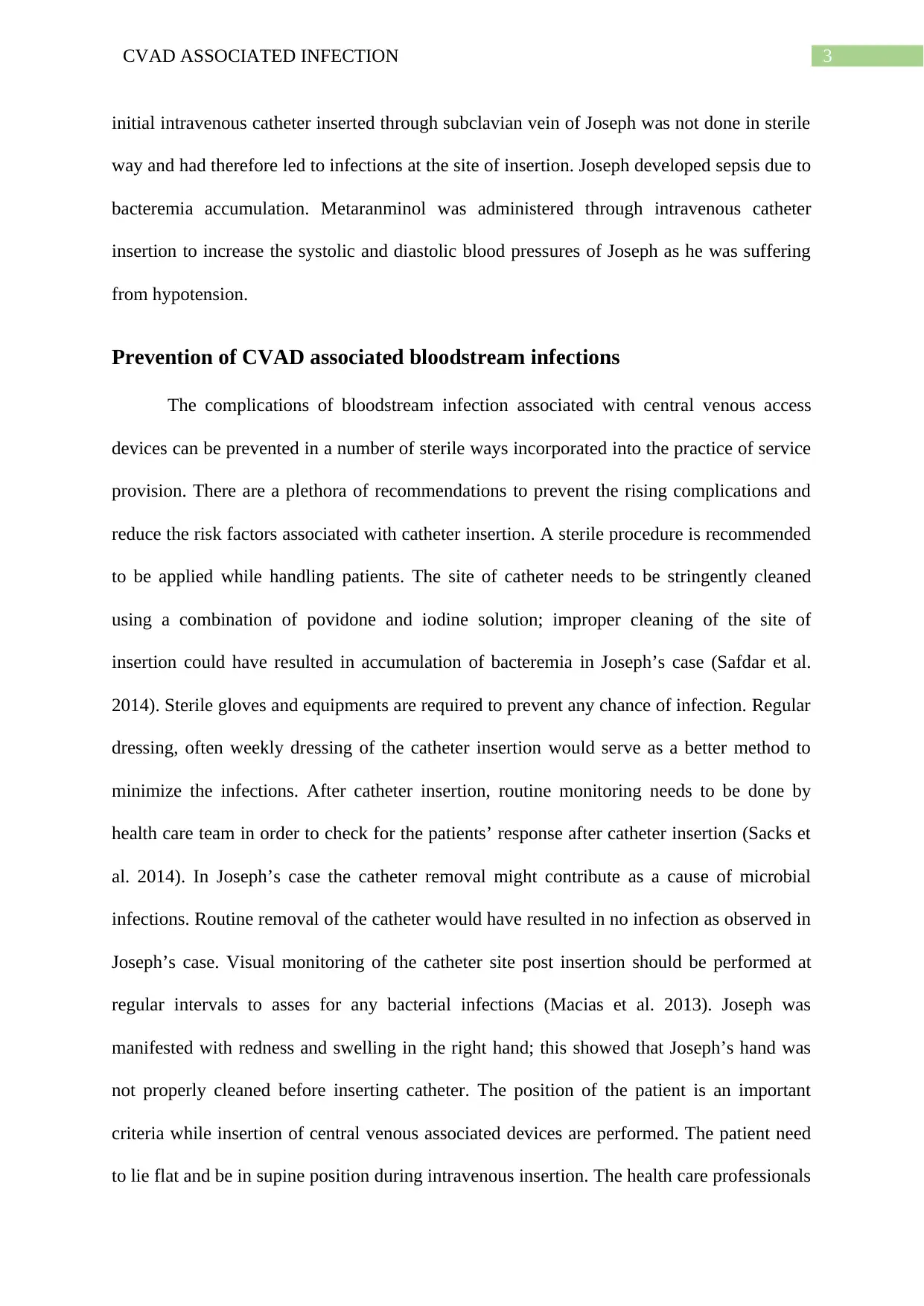
3CVAD ASSOCIATED INFECTION
initial intravenous catheter inserted through subclavian vein of Joseph was not done in sterile
way and had therefore led to infections at the site of insertion. Joseph developed sepsis due to
bacteremia accumulation. Metaranminol was administered through intravenous catheter
insertion to increase the systolic and diastolic blood pressures of Joseph as he was suffering
from hypotension.
Prevention of CVAD associated bloodstream infections
The complications of bloodstream infection associated with central venous access
devices can be prevented in a number of sterile ways incorporated into the practice of service
provision. There are a plethora of recommendations to prevent the rising complications and
reduce the risk factors associated with catheter insertion. A sterile procedure is recommended
to be applied while handling patients. The site of catheter needs to be stringently cleaned
using a combination of povidone and iodine solution; improper cleaning of the site of
insertion could have resulted in accumulation of bacteremia in Joseph’s case (Safdar et al.
2014). Sterile gloves and equipments are required to prevent any chance of infection. Regular
dressing, often weekly dressing of the catheter insertion would serve as a better method to
minimize the infections. After catheter insertion, routine monitoring needs to be done by
health care team in order to check for the patients’ response after catheter insertion (Sacks et
al. 2014). In Joseph’s case the catheter removal might contribute as a cause of microbial
infections. Routine removal of the catheter would have resulted in no infection as observed in
Joseph’s case. Visual monitoring of the catheter site post insertion should be performed at
regular intervals to asses for any bacterial infections (Macias et al. 2013). Joseph was
manifested with redness and swelling in the right hand; this showed that Joseph’s hand was
not properly cleaned before inserting catheter. The position of the patient is an important
criteria while insertion of central venous associated devices are performed. The patient need
to lie flat and be in supine position during intravenous insertion. The health care professionals
initial intravenous catheter inserted through subclavian vein of Joseph was not done in sterile
way and had therefore led to infections at the site of insertion. Joseph developed sepsis due to
bacteremia accumulation. Metaranminol was administered through intravenous catheter
insertion to increase the systolic and diastolic blood pressures of Joseph as he was suffering
from hypotension.
Prevention of CVAD associated bloodstream infections
The complications of bloodstream infection associated with central venous access
devices can be prevented in a number of sterile ways incorporated into the practice of service
provision. There are a plethora of recommendations to prevent the rising complications and
reduce the risk factors associated with catheter insertion. A sterile procedure is recommended
to be applied while handling patients. The site of catheter needs to be stringently cleaned
using a combination of povidone and iodine solution; improper cleaning of the site of
insertion could have resulted in accumulation of bacteremia in Joseph’s case (Safdar et al.
2014). Sterile gloves and equipments are required to prevent any chance of infection. Regular
dressing, often weekly dressing of the catheter insertion would serve as a better method to
minimize the infections. After catheter insertion, routine monitoring needs to be done by
health care team in order to check for the patients’ response after catheter insertion (Sacks et
al. 2014). In Joseph’s case the catheter removal might contribute as a cause of microbial
infections. Routine removal of the catheter would have resulted in no infection as observed in
Joseph’s case. Visual monitoring of the catheter site post insertion should be performed at
regular intervals to asses for any bacterial infections (Macias et al. 2013). Joseph was
manifested with redness and swelling in the right hand; this showed that Joseph’s hand was
not properly cleaned before inserting catheter. The position of the patient is an important
criteria while insertion of central venous associated devices are performed. The patient need
to lie flat and be in supine position during intravenous insertion. The health care professionals
Paraphrase This Document
Need a fresh take? Get an instant paraphrase of this document with our AI Paraphraser
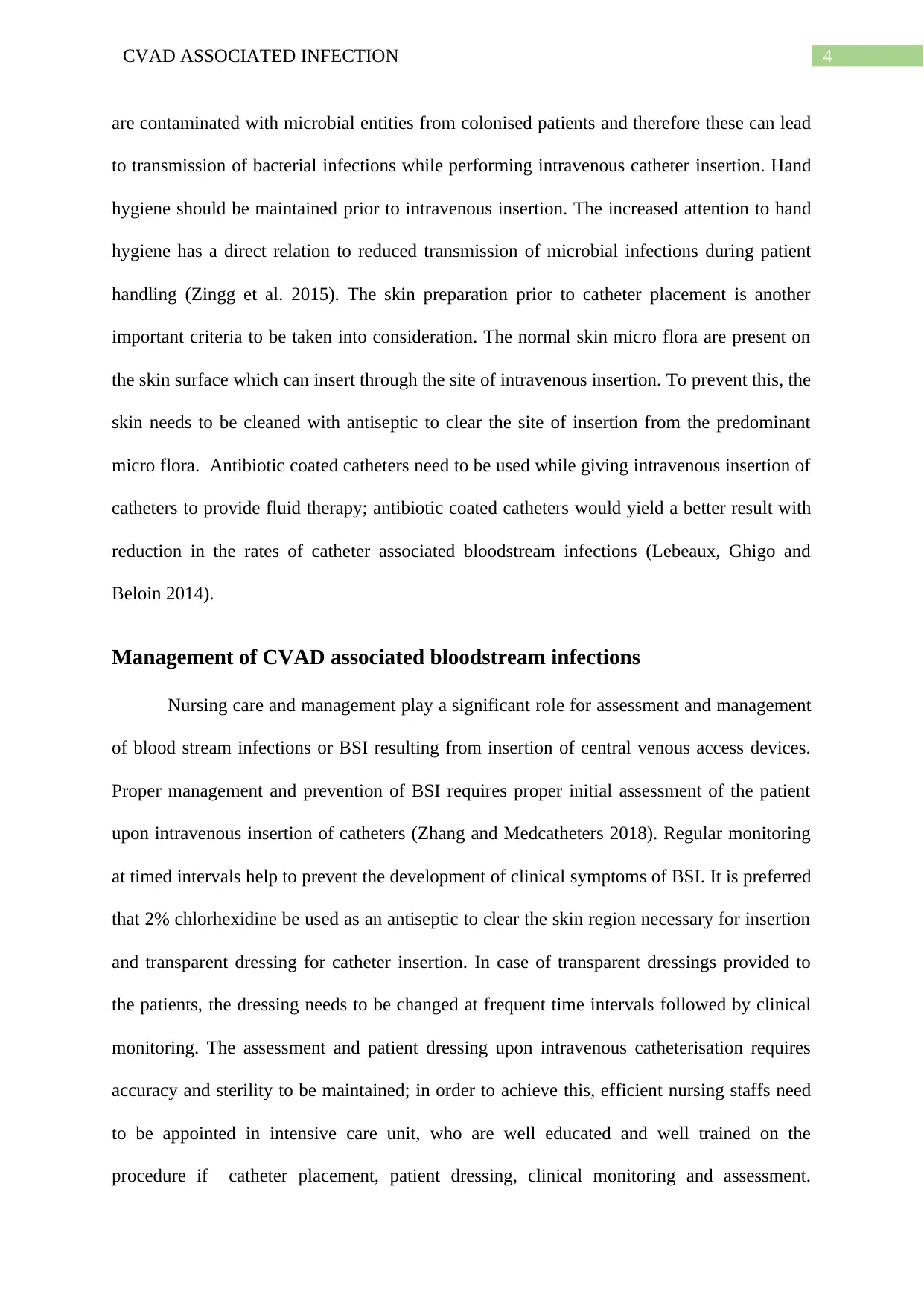
4CVAD ASSOCIATED INFECTION
are contaminated with microbial entities from colonised patients and therefore these can lead
to transmission of bacterial infections while performing intravenous catheter insertion. Hand
hygiene should be maintained prior to intravenous insertion. The increased attention to hand
hygiene has a direct relation to reduced transmission of microbial infections during patient
handling (Zingg et al. 2015). The skin preparation prior to catheter placement is another
important criteria to be taken into consideration. The normal skin micro flora are present on
the skin surface which can insert through the site of intravenous insertion. To prevent this, the
skin needs to be cleaned with antiseptic to clear the site of insertion from the predominant
micro flora. Antibiotic coated catheters need to be used while giving intravenous insertion of
catheters to provide fluid therapy; antibiotic coated catheters would yield a better result with
reduction in the rates of catheter associated bloodstream infections (Lebeaux, Ghigo and
Beloin 2014).
Management of CVAD associated bloodstream infections
Nursing care and management play a significant role for assessment and management
of blood stream infections or BSI resulting from insertion of central venous access devices.
Proper management and prevention of BSI requires proper initial assessment of the patient
upon intravenous insertion of catheters (Zhang and Medcatheters 2018). Regular monitoring
at timed intervals help to prevent the development of clinical symptoms of BSI. It is preferred
that 2% chlorhexidine be used as an antiseptic to clear the skin region necessary for insertion
and transparent dressing for catheter insertion. In case of transparent dressings provided to
the patients, the dressing needs to be changed at frequent time intervals followed by clinical
monitoring. The assessment and patient dressing upon intravenous catheterisation requires
accuracy and sterility to be maintained; in order to achieve this, efficient nursing staffs need
to be appointed in intensive care unit, who are well educated and well trained on the
procedure if catheter placement, patient dressing, clinical monitoring and assessment.
are contaminated with microbial entities from colonised patients and therefore these can lead
to transmission of bacterial infections while performing intravenous catheter insertion. Hand
hygiene should be maintained prior to intravenous insertion. The increased attention to hand
hygiene has a direct relation to reduced transmission of microbial infections during patient
handling (Zingg et al. 2015). The skin preparation prior to catheter placement is another
important criteria to be taken into consideration. The normal skin micro flora are present on
the skin surface which can insert through the site of intravenous insertion. To prevent this, the
skin needs to be cleaned with antiseptic to clear the site of insertion from the predominant
micro flora. Antibiotic coated catheters need to be used while giving intravenous insertion of
catheters to provide fluid therapy; antibiotic coated catheters would yield a better result with
reduction in the rates of catheter associated bloodstream infections (Lebeaux, Ghigo and
Beloin 2014).
Management of CVAD associated bloodstream infections
Nursing care and management play a significant role for assessment and management
of blood stream infections or BSI resulting from insertion of central venous access devices.
Proper management and prevention of BSI requires proper initial assessment of the patient
upon intravenous insertion of catheters (Zhang and Medcatheters 2018). Regular monitoring
at timed intervals help to prevent the development of clinical symptoms of BSI. It is preferred
that 2% chlorhexidine be used as an antiseptic to clear the skin region necessary for insertion
and transparent dressing for catheter insertion. In case of transparent dressings provided to
the patients, the dressing needs to be changed at frequent time intervals followed by clinical
monitoring. The assessment and patient dressing upon intravenous catheterisation requires
accuracy and sterility to be maintained; in order to achieve this, efficient nursing staffs need
to be appointed in intensive care unit, who are well educated and well trained on the
procedure if catheter placement, patient dressing, clinical monitoring and assessment.
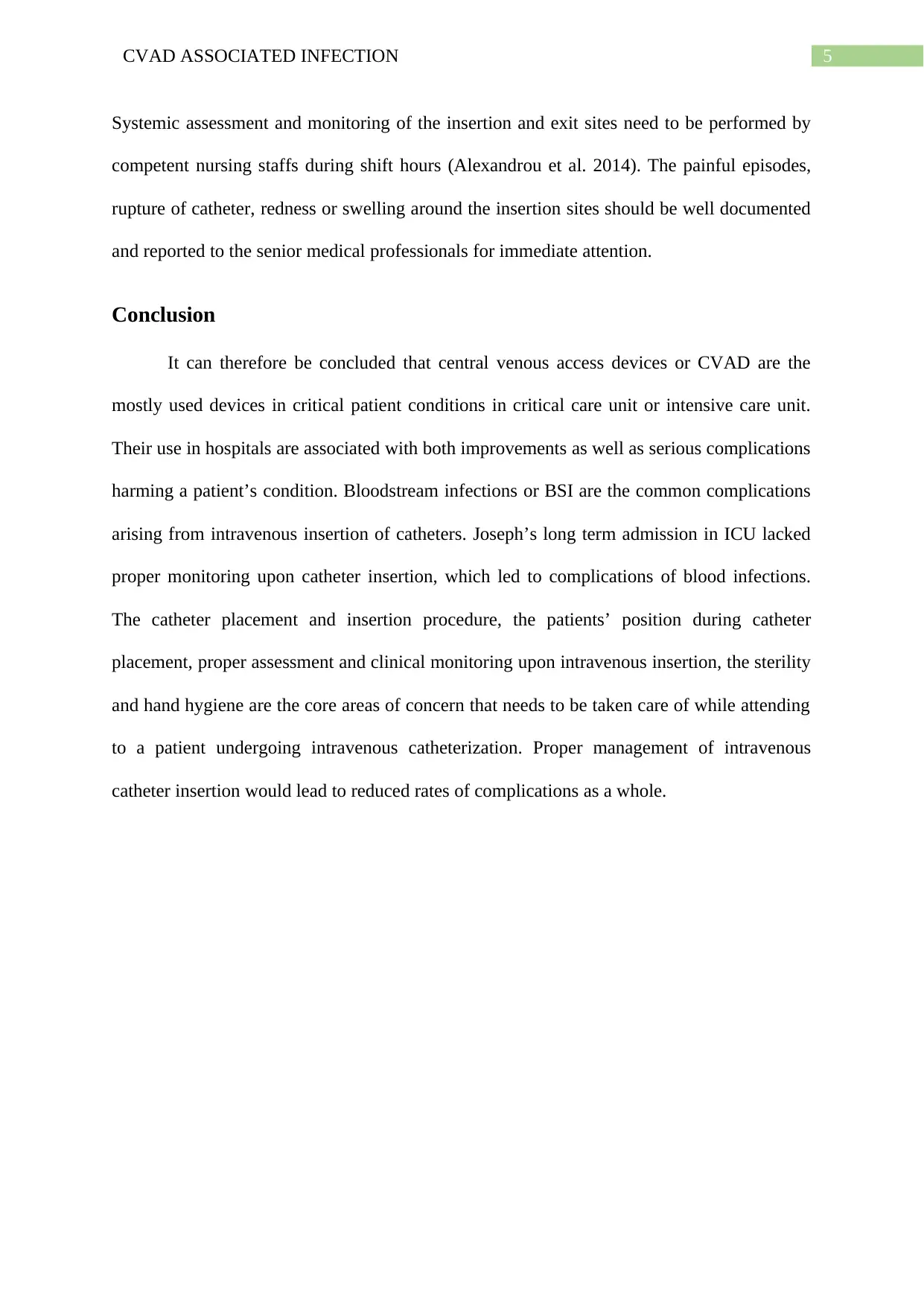
5CVAD ASSOCIATED INFECTION
Systemic assessment and monitoring of the insertion and exit sites need to be performed by
competent nursing staffs during shift hours (Alexandrou et al. 2014). The painful episodes,
rupture of catheter, redness or swelling around the insertion sites should be well documented
and reported to the senior medical professionals for immediate attention.
Conclusion
It can therefore be concluded that central venous access devices or CVAD are the
mostly used devices in critical patient conditions in critical care unit or intensive care unit.
Their use in hospitals are associated with both improvements as well as serious complications
harming a patient’s condition. Bloodstream infections or BSI are the common complications
arising from intravenous insertion of catheters. Joseph’s long term admission in ICU lacked
proper monitoring upon catheter insertion, which led to complications of blood infections.
The catheter placement and insertion procedure, the patients’ position during catheter
placement, proper assessment and clinical monitoring upon intravenous insertion, the sterility
and hand hygiene are the core areas of concern that needs to be taken care of while attending
to a patient undergoing intravenous catheterization. Proper management of intravenous
catheter insertion would lead to reduced rates of complications as a whole.
Systemic assessment and monitoring of the insertion and exit sites need to be performed by
competent nursing staffs during shift hours (Alexandrou et al. 2014). The painful episodes,
rupture of catheter, redness or swelling around the insertion sites should be well documented
and reported to the senior medical professionals for immediate attention.
Conclusion
It can therefore be concluded that central venous access devices or CVAD are the
mostly used devices in critical patient conditions in critical care unit or intensive care unit.
Their use in hospitals are associated with both improvements as well as serious complications
harming a patient’s condition. Bloodstream infections or BSI are the common complications
arising from intravenous insertion of catheters. Joseph’s long term admission in ICU lacked
proper monitoring upon catheter insertion, which led to complications of blood infections.
The catheter placement and insertion procedure, the patients’ position during catheter
placement, proper assessment and clinical monitoring upon intravenous insertion, the sterility
and hand hygiene are the core areas of concern that needs to be taken care of while attending
to a patient undergoing intravenous catheterization. Proper management of intravenous
catheter insertion would lead to reduced rates of complications as a whole.
⊘ This is a preview!⊘
Do you want full access?
Subscribe today to unlock all pages.

Trusted by 1+ million students worldwide
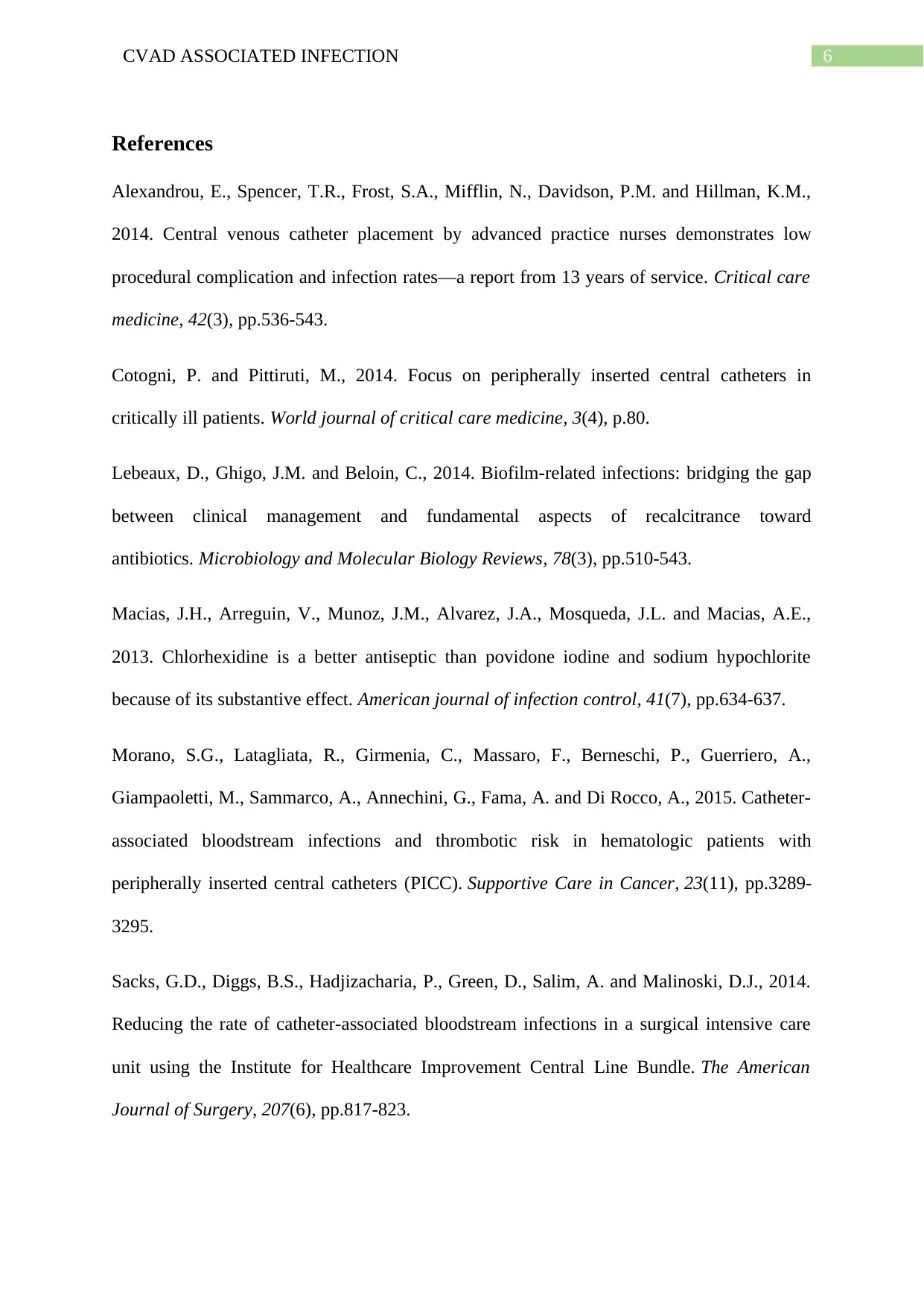
6CVAD ASSOCIATED INFECTION
References
Alexandrou, E., Spencer, T.R., Frost, S.A., Mifflin, N., Davidson, P.M. and Hillman, K.M.,
2014. Central venous catheter placement by advanced practice nurses demonstrates low
procedural complication and infection rates—a report from 13 years of service. Critical care
medicine, 42(3), pp.536-543.
Cotogni, P. and Pittiruti, M., 2014. Focus on peripherally inserted central catheters in
critically ill patients. World journal of critical care medicine, 3(4), p.80.
Lebeaux, D., Ghigo, J.M. and Beloin, C., 2014. Biofilm-related infections: bridging the gap
between clinical management and fundamental aspects of recalcitrance toward
antibiotics. Microbiology and Molecular Biology Reviews, 78(3), pp.510-543.
Macias, J.H., Arreguin, V., Munoz, J.M., Alvarez, J.A., Mosqueda, J.L. and Macias, A.E.,
2013. Chlorhexidine is a better antiseptic than povidone iodine and sodium hypochlorite
because of its substantive effect. American journal of infection control, 41(7), pp.634-637.
Morano, S.G., Latagliata, R., Girmenia, C., Massaro, F., Berneschi, P., Guerriero, A.,
Giampaoletti, M., Sammarco, A., Annechini, G., Fama, A. and Di Rocco, A., 2015. Catheter-
associated bloodstream infections and thrombotic risk in hematologic patients with
peripherally inserted central catheters (PICC). Supportive Care in Cancer, 23(11), pp.3289-
3295.
Sacks, G.D., Diggs, B.S., Hadjizacharia, P., Green, D., Salim, A. and Malinoski, D.J., 2014.
Reducing the rate of catheter-associated bloodstream infections in a surgical intensive care
unit using the Institute for Healthcare Improvement Central Line Bundle. The American
Journal of Surgery, 207(6), pp.817-823.
References
Alexandrou, E., Spencer, T.R., Frost, S.A., Mifflin, N., Davidson, P.M. and Hillman, K.M.,
2014. Central venous catheter placement by advanced practice nurses demonstrates low
procedural complication and infection rates—a report from 13 years of service. Critical care
medicine, 42(3), pp.536-543.
Cotogni, P. and Pittiruti, M., 2014. Focus on peripherally inserted central catheters in
critically ill patients. World journal of critical care medicine, 3(4), p.80.
Lebeaux, D., Ghigo, J.M. and Beloin, C., 2014. Biofilm-related infections: bridging the gap
between clinical management and fundamental aspects of recalcitrance toward
antibiotics. Microbiology and Molecular Biology Reviews, 78(3), pp.510-543.
Macias, J.H., Arreguin, V., Munoz, J.M., Alvarez, J.A., Mosqueda, J.L. and Macias, A.E.,
2013. Chlorhexidine is a better antiseptic than povidone iodine and sodium hypochlorite
because of its substantive effect. American journal of infection control, 41(7), pp.634-637.
Morano, S.G., Latagliata, R., Girmenia, C., Massaro, F., Berneschi, P., Guerriero, A.,
Giampaoletti, M., Sammarco, A., Annechini, G., Fama, A. and Di Rocco, A., 2015. Catheter-
associated bloodstream infections and thrombotic risk in hematologic patients with
peripherally inserted central catheters (PICC). Supportive Care in Cancer, 23(11), pp.3289-
3295.
Sacks, G.D., Diggs, B.S., Hadjizacharia, P., Green, D., Salim, A. and Malinoski, D.J., 2014.
Reducing the rate of catheter-associated bloodstream infections in a surgical intensive care
unit using the Institute for Healthcare Improvement Central Line Bundle. The American
Journal of Surgery, 207(6), pp.817-823.
Paraphrase This Document
Need a fresh take? Get an instant paraphrase of this document with our AI Paraphraser
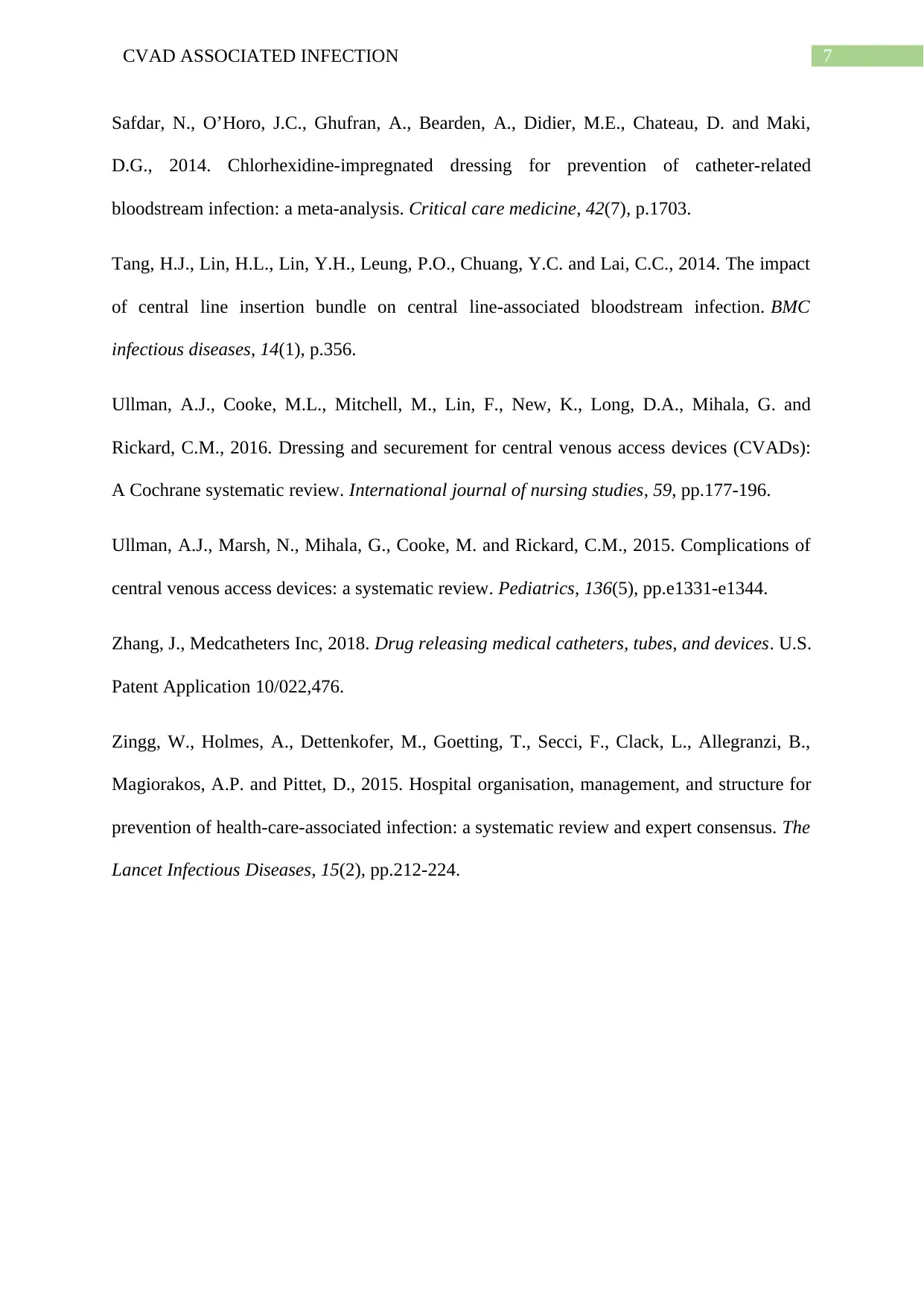
7CVAD ASSOCIATED INFECTION
Safdar, N., O’Horo, J.C., Ghufran, A., Bearden, A., Didier, M.E., Chateau, D. and Maki,
D.G., 2014. Chlorhexidine-impregnated dressing for prevention of catheter-related
bloodstream infection: a meta-analysis. Critical care medicine, 42(7), p.1703.
Tang, H.J., Lin, H.L., Lin, Y.H., Leung, P.O., Chuang, Y.C. and Lai, C.C., 2014. The impact
of central line insertion bundle on central line-associated bloodstream infection. BMC
infectious diseases, 14(1), p.356.
Ullman, A.J., Cooke, M.L., Mitchell, M., Lin, F., New, K., Long, D.A., Mihala, G. and
Rickard, C.M., 2016. Dressing and securement for central venous access devices (CVADs):
A Cochrane systematic review. International journal of nursing studies, 59, pp.177-196.
Ullman, A.J., Marsh, N., Mihala, G., Cooke, M. and Rickard, C.M., 2015. Complications of
central venous access devices: a systematic review. Pediatrics, 136(5), pp.e1331-e1344.
Zhang, J., Medcatheters Inc, 2018. Drug releasing medical catheters, tubes, and devices. U.S.
Patent Application 10/022,476.
Zingg, W., Holmes, A., Dettenkofer, M., Goetting, T., Secci, F., Clack, L., Allegranzi, B.,
Magiorakos, A.P. and Pittet, D., 2015. Hospital organisation, management, and structure for
prevention of health-care-associated infection: a systematic review and expert consensus. The
Lancet Infectious Diseases, 15(2), pp.212-224.
Safdar, N., O’Horo, J.C., Ghufran, A., Bearden, A., Didier, M.E., Chateau, D. and Maki,
D.G., 2014. Chlorhexidine-impregnated dressing for prevention of catheter-related
bloodstream infection: a meta-analysis. Critical care medicine, 42(7), p.1703.
Tang, H.J., Lin, H.L., Lin, Y.H., Leung, P.O., Chuang, Y.C. and Lai, C.C., 2014. The impact
of central line insertion bundle on central line-associated bloodstream infection. BMC
infectious diseases, 14(1), p.356.
Ullman, A.J., Cooke, M.L., Mitchell, M., Lin, F., New, K., Long, D.A., Mihala, G. and
Rickard, C.M., 2016. Dressing and securement for central venous access devices (CVADs):
A Cochrane systematic review. International journal of nursing studies, 59, pp.177-196.
Ullman, A.J., Marsh, N., Mihala, G., Cooke, M. and Rickard, C.M., 2015. Complications of
central venous access devices: a systematic review. Pediatrics, 136(5), pp.e1331-e1344.
Zhang, J., Medcatheters Inc, 2018. Drug releasing medical catheters, tubes, and devices. U.S.
Patent Application 10/022,476.
Zingg, W., Holmes, A., Dettenkofer, M., Goetting, T., Secci, F., Clack, L., Allegranzi, B.,
Magiorakos, A.P. and Pittet, D., 2015. Hospital organisation, management, and structure for
prevention of health-care-associated infection: a systematic review and expert consensus. The
Lancet Infectious Diseases, 15(2), pp.212-224.

8CVAD ASSOCIATED INFECTION
⊘ This is a preview!⊘
Do you want full access?
Subscribe today to unlock all pages.

Trusted by 1+ million students worldwide
1 out of 9
Related Documents
Your All-in-One AI-Powered Toolkit for Academic Success.
+13062052269
info@desklib.com
Available 24*7 on WhatsApp / Email
![[object Object]](/_next/static/media/star-bottom.7253800d.svg)
Unlock your academic potential
Copyright © 2020–2025 A2Z Services. All Rights Reserved. Developed and managed by ZUCOL.





